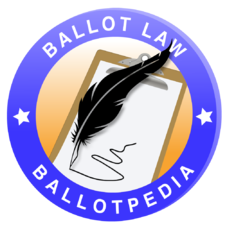Constitutional revision
The term constitutional revision is used in the context of changes to a state constitution. The exact definition differs from state to state and is established in state constitutional law and case law. A constitutional revision is different from a constitutional amendment. While a constitutional amendment is written to amend specific articles or sections of a state's constitution, a constitutional revision is a fundamental and holistic change to a state's constitution.
Typically, in states that differentiate between constitutional amendments and constitutional revisions, a constitutional revision requires a state constitutional convention.
Lawsuits
The following is a selection of case law and litigation about constitutional revisions.
California
- Strauss v. Horton (2009): The California Supreme Court ruled that Proposition 8, which defined marriage as between one man and one woman, was a constitutional amendment, not a constitutional revision. Plaintiffs argued that Proposition 8 was a constitutional revision. The state Supreme Court held, "... the act of limiting access to the designation of marriage to opposite-sex couples does not have a substantial or, indeed, even a minimal effect on the governmental plan or framework of California that existed prior to the amendment."[1]
- People v. Frierson (1979): The California Supreme Court held that Proposition 7, passed in 1978, was a constitutional amendment. Attorneys for Lavell Frierson, who had been sentenced to death, argued that Proposition 7 was a constitutional revision that removed judicial review from death sentences, resulting in a "significant change in a principle underlying our system of democratic government and can only be accomplished by constitutional revision." The state Supreme Court held that Proposition 7 was "not so broad as to constitute a fundamental constitutional revision."[2]
- Amador Valley Joint Union High School District v. State Board of Equalization (1978): The Amador Valley Joint Union High School District challenged Proposition 13 in the California Supreme Court. The school district argued that Proposition 13 caused "such a drastic and far-reaching change in the nature and operation of our governmental structure" that the initiative should be considered a constitutional revision, not a constitutional amendment. The state Supreme Court ruled, "[We] are convinced that Article XIII A [Proposition 13] is more modest both in concept and effect and does not change our basic governmental plan... both local and state government will continue to function through the traditional system of elected representation."[3]
- McFadden v. Jordan (1948): In 1948, a citizen-initiated constitutional amendment qualified for the ballot. This initiative would have added 21,000 words to the California Constitution, which was 55,000 words at the time. According to the California Supreme Court, the initiative addressed "various ethical, economic and governmental concepts and philosophies." "[T]he proposed measure is revisory rather than amendatory in nature," wrote the court, "[dealing] with such varied and diverse subjects as retirement pensions, gambling, taxes, oleomargarine, healing arts, civic centers, senate reapportionment, fish and game, and surface mining."[4]
Florida
- Adams v. Gunter (1970): The Florida Supreme Court ruled that a proposed ballot initiative to replace the state's bicameral legislature with a unicameral legislature was a constitutional revision. The state Supreme Court wrote, "We conclude with the observation that if such proposed amendment were adopted by the people at the General Election... simple chaos would prevail in the government of this State." The court's opinion said that a constitutional convention was needed to propose such a change, "If it should become necessary in the course of events for the people to bring about such cataclysmic change as that which would result in the adoption of the amendments here under consideration... the people have reserved unto themselves a means of bringing about such a revision by initiating under the provisions of Section 4 of Article XI a convention to consider a revision of the entire Constitution."[5]
South Dakota
- Thom and Barnett v. South Dakotans for Better Marijuana Laws et al. (2021): The Hughes County Circuit Court ruled that Amendment A, which was related to marijuana legalization, was a constitutional revision, rather than a constitutional amendment. The South Dakota Supreme Court upheld the ruling on other grounds—violation of the state's single-subject rule—and did not address whether Amendment A was a constitutional revision.[6] Circuit Court Judge Christina Klinger noted, "The South Dakota Supreme Court has never directly ascertained the difference between an amendment and a revision." She wrote, "Amendment A provides far-reaching changes to the nature of South Dakota’s governmental plan and is therefore a revision. Several provisions of Amendment A implement 'far reaching changes' in the basic nature of South Dakota’s governmental system by taking authority given to the Legislative and Executive branches and allocating it to the Department of Revenue."[7]
Other types of ballot measures
Most ballot measures are placed on the ballot through citizen initiatives or legislative processes. Others are placed on the ballot automatically, by a special commission, or by a state constitutional convention. The following is a list of different types of state ballot measures:
See also
- Laws governing ballot measures
- States with initiative or referendum
- States without initiative or referendum
- States with initiated statutes only
- States with veto referendum only
- States that allow initiated constitutional amendments
- List of ballot measures by state
Footnotes
- ↑ California Supreme Court, "Strauss v. Horton," May 26, 2009
- ↑ California Supreme Court, "People v. Frierson," August 31, 1979
- ↑ California Supreme Court, "Amador Valley Joint Union High School District v. State Board of Equalization," September 22, 1978
- ↑ California Supreme Court, "McFadden v. Jordan," August 3, 1948
- ↑ Florida Supreme Court, "Adams v. Gunter," September 21, 2023
- ↑ South Dakota Supreme Court, "Thom and Barnett v. South Dakotans for Better Marijuana Laws et al.," September 7, 2021
- ↑ Hughes County Circuit Court, "Thom and Barnett v. South Dakotans for Better Marijuana Laws et al.," February 8, 2021
| ||||||||||||||
